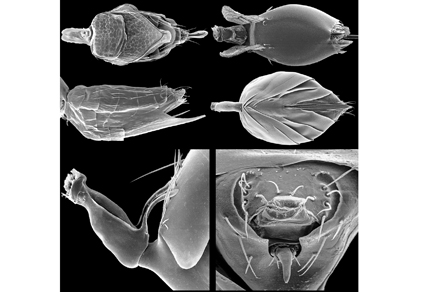Abstract
This is the third in a series of studies that aim to provide an overview of the morphological diversity of Mymaridae (Hymenoptera) or fairyflies, a monophyletic family of small parasitic wasps postulated as the sister group of all other Chalcidoidea. The external morphology of the metasoma of about half of the 115 currently valid described genera and subgenera is described and illustrated with about 460 scanning electron micrographs. Fifteen annotated figures of external metasoma structures and the male genitalia are included. The names of the 75 genera and subgenera illustrated, at least in part, are tabulated. An appendix lists the 23 acronyms used for morphological terms. The variety of characters and their features that could be used to help define morphologically the genera, and possibly also the species, of Mymaridae is briefly discussed.
References
- Annecke, D.P. & Doutt, R.L. (1961) The genera of the Mymaridae. Hymenoptera: Chalcidoidea. Republic of South Africa. Department of Agricultural Technical Services. Entomology Memoirs, 5, 1–71.
- Bolte, K.B. 1997 (1996) Techniques for obtaining scanning electron micrographs of minute arthropods. Proceedings of the Entomological Society of Ontario, 127, 67–87.
- Burks, R.A., Gibson, G.A.P. & Heraty, J.M. (2024) Chapter 4. External morphology of adult Chalcidoidea. In: Heraty, J.M. & Woolley, J.B. (Eds.), Chalcidoidea of the World. CABI, Wallingford. [in press]
- Dal Pos, D., Mikó, I., Talamas, E.J., Vilhelmsen, L. & Sharanowski, B.J. (2023) A revised terminology for male genitalia in Hymenoptera (Insecta), with a special emphasis on Ichneumonoidea. PeerJ, 11, e15874. https://doi.org/10.7717/peerj.15874
- Huber, J.T., Bolte, K. & Read, J.D. (2023a) The morphological diversity of Mymaridae (Hymenoptera): an atlas of scanning electron micrographs. Part 1. General overview and structure of the head. Zootaxa, 5273 (1), 1–100. https://doi.org/10.11646/zootaxa.5273.1.1
- Huber, J.T., Bolte, K. & Read, J.D. (2023b) The morphological diversity of Mymaridae (Hymenoptera): an atlas of scanning electron micrographs. Part 2. Structure of the mesosoma. Zootaxa, 5273 (1), 1–70. https://doi.org/10.11646/zootaxa.5337.1.1
- Huber, J.T. & Lin, N.-Q. (1999) World review of the Camptoptera group of genera (Hymenoptera: Mymaridae). Proceedings of the Entomological Society of Ontario, 130, 21–65.
- Huber, J.T. & Noyes, J.S. (2013) A new genus and species of fairyfly, Tinkerbella nana (Hymenoptera, Mymaridae), with comments on its sister genus Kikiki, and discussion on small size limits in arthropods. Journal of Hymenoptera Research, 32, 17–44. https://doi.org/10.3897/jhr.32.4663
- King, P.E. & Copland, M.J.W. (1969) The structure of the female reproductive system in the Mymaridae (Chalcidoidea: Hymenoptera). Journal of Natural History, 3, 349–365. https://doi.org/10.1080/00222936900770311
- Lieberman, Z.E., Billen, J., Kamp, van de, T. & Boudinot, B.E. (2021) The ant abdomen: The skeletomuscular and soft tissue anatomy of Amblyopone australis workers (Hymenoptera: Formicidae). Journal of Morphology, 283(6), 1–78. https://doi.org/10.1002/jmor.21471
- Lin, N.-Q., Huber, J.T. & La Salle, J. (2007) The Australian genera of Mymaridae (Hymenoptera: Chalcidoidea). Zootaxa, 1596 (1), 1–111. https://doi.org/10.11646/zootaxa.1596.1.1
- Viggiani, G. (1970) Ricerche sugli Hymenoptera Chalcidoidea XXIV. Sul valore tassinomico dell’organo copulatore nei Mimaridi del genere Anagrus. Bollettino del Laboratorio di Entomologia Agraria «Filippo Silvestri», 28, 10–18.
- Viggiani, G. (1973) Ricerche sugli Hymenoptera Chalcidoidea XXXIX. Notizie preliminari sulla struttura e sul significato dell’armatura genitale esterna maschile dei Mimaridi. Bollettino del Laboratorio di Entomologia Agraria «Filippo Silvestri», 30, 269–281.
- Viggiani, G. (1989 [1988]) A preliminary classification of the Mymaridae (Hymenoptera: Chalcidoidea) based on the external male genitalic characters. Bollettino del Laboratorio di Entomologia Agraria «Filippo Silvestri», 45, 141–148.
- Viggiani, G. (1991) Structure of the male genitalia and mating behaviour in Lymaenon terebrator (Förster) (Hymenoptera: Mymaridae). Redia, 74 (3 «Appendice»), 365–371.
- Viggiani, G. (1994) L’armatura genitale esterna maschile di alcune specie di Anaphes Haliday (Hymenoptera Mymaridae). Memorie della Società Entomologica Italiana, 72, 469–478.
- Viggiani, G. (2004 [2003]) A further contribution to the knowledge of the male genitalia in the Mymaridae (Hymenoptera: Chalcidoidea). Bollettino del Laboratorio di Entomologia Agraria «Filippo Silvestri», 59, 59–74.


